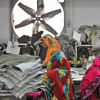The case for a creative fashion policy in Bangladesh

Bangladesh is the friend who styles everyone else for the party but shows up wearing a borrowed fit. We are the world's second-largest clothing exporter. Our garments fill wardrobes from New York to Nairobi, and our factories operate around the clock to meet global demand. Yet, we remain barely present in the conversation on design, craft, and fashion identity. From the factory floors of Savar to the fashion capitals of the world, we manage to ship every label but our own.
It's an irony woven into our national fabric: our factories are masters of mass production, but our designers struggle. The issue isn't talent—Bangladesh is overflowing with creativity—it's that our system rewards volume rather than vision. The government has perfected the art of facilitating exports but failed spectacularly at nurturing the creators. And therein lies the problem: we continue to treat fashion as an optional industry instead of a part of our identity.
In Bangladesh, our signature styles (jamdani, muslin, nakshi kantha) are seldom part of contemporary fashion. At the heart of this disconnect lies an ecosystem that suppresses creativity. Local designers attempting to establish brands in Bangladesh are fighting a battle they did not choose. The first obstacle starts with the fabric. Our mills are designed for bulk orders—thousands of identical T-shirts for European chains—not for small-scale designers aiming to produce 50 unique, high-quality pieces. The required minimum order quantity is excessively high, and even if a designer manages to persuade a factory to accept a smaller order, the price per metre becomes prohibitively costly. Importing fabric isn't any easier; taxes and duties increase the cost of high-quality silk, chiffon, or lace to the point where the final product becomes unaffordable for local buyers. Designers are left with a bleak choice: compromise on quality or profit. Most end up doing both.
Then comes the challenge of production. The country's garment infrastructure—our economic backbone—is built for scale, not for creativity. Large factories have no incentive to collaborate with independent designers who produce limited quantities. Small workshops, on the other hand, lack quality control and technical expertise. Designers trying to meet professional standards often find themselves pleading for production slots squeezed between export deadlines. Add to this the ever-present threat of design theft—where collections are copied and sold as fast-fashion dupes within weeks—and it becomes painfully clear why many local designers give up.
Now compare this with our neighbouring countries. They have built ecosystems that reward designers, not just manufacturers. Their governments support textile innovation, fund international showcases, and, most importantly, invest in brand-building. Those fashion houses that became global names had access to materials, mentorship, and markets. In contrast, a Bangladeshi designer spends half their career just sourcing fabric and the other half justifying why their "Made in Bangladesh" tag doesn't mean factory-made.
Our middle class, though increasingly fashion-conscious, still associates prestige with imported clothing. A Pakistani designer lawn suit or an Indian saree is considered aspirational. A Bangladeshi one is deemed ordinary. This colonial hangover of taste makes it nearly impossible for local brands to charge what they're worth. Designers are constantly asked, "Why is it so expensive if it's made here?" As if local creativity should come at a discount. Until we break this mindset that imported means superior, our designers will remain underappreciated.
However, the government cannot be excused. Policy has consistently ignored the creative economy. Every incentive, every subsidy, every rebate is designed around mass manufacturing and export metrics. The ready-made garment (RMG) industry benefits from tax breaks, bonded warehouses, and duty-free imports of machinery. Yet the same facilities are inaccessible to small design houses. Designers cannot import fabric without paying exorbitant duties. They cannot access export incentives unless they produce at a massive scale. They cannot even open showrooms abroad without navigating a maze of banking regulations and foreign exchange controls. We have built a bureaucracy that rewards repetition and punishes originality.
If Bangladesh truly wants to climb the global value chain, it must rethink its strategy. The government needs to stop acting like a compliance officer and start functioning like a cultural investor. That begins with policy—bold, clear, and unapologetically creative.
First, establish a national fashion and textile council. This should not be a ceremonial committee but a statutory body with real authority. Its mandate should include fashion promotion, craft revival, global market access, and representation of designers in trade policy. The council must be comprised of individuals who genuinely understand fashion—designers, artisans, and textile experts—not just exporters and bureaucrats.
Second, create a creative export fund—a government-backed financing scheme offering grants, low-interest loans, and export assistance to emerging designers. If we can subsidise shrimp farms, we can certainly invest in our cultural capital. The fund could cover participation in international fairs, support e-commerce infrastructure, and underwrite collaborations with global brands.
Third, solve the fabric crisis. Offer tax breaks to mills that produce small-batch, high-end textiles. Set up design-friendly industrial clusters where small labels can access shared production facilities—such as cutting, dyeing, and pattern-making—without the burden of massive capital investment. Reduce import duties on speciality fabrics and trims, ensuring fair access for small importers. It is absurd that a country exporting billions in garments cannot provide affordable fabric for its own designers.
Fourth, make heritage a strategy, not a museum caption. Jamdani already has geographical indication status; now, fund design residencies that pair weavers with contemporary designers, guarantee a minimum take for high-skill looms, and protect patterns with enforceable intellectual property (IP) rights so our motifs cannot be free clip art for someone else's runway.
Finally, invest in fashion education and innovation. Reform existing fashion universities and technical institutes by introducing global exchange programmes, residencies, and visiting faculty from established fashion capitals. Provide scholarships for designers to study abroad, with the requirement that they return to mentor others. Encourage research into sustainable fabrics and the revival of heritage textiles.
The outcome of these reforms would be more than just better fashion—it would be better nation branding. When a Bangladeshi label appears at an international platform, it changes how the world perceives "Made in Bangladesh." It signals that we are not just a global factory, but a source of artistry, heritage, and innovation. And when our own citizens begin to wear those same labels with pride, it means something even greater—that we have finally learnt to value our own creativity. The threads of pride, culture, and creativity are already in our hands. All we need now is a government willing to stitch them together.
Barrister Noshin Nawal is a columnist for The Daily Star. She can be reached at [email protected].
Views expressed in this article are the author's own.
Follow The Daily Star Opinion on Facebook for the latest opinions, commentaries and analyses by experts and professionals. To contribute your article or letter to The Daily Star Opinion, see our guidelines for submission.

 For all latest news, follow The Daily Star's Google News channel.
For all latest news, follow The Daily Star's Google News channel. 










Comments